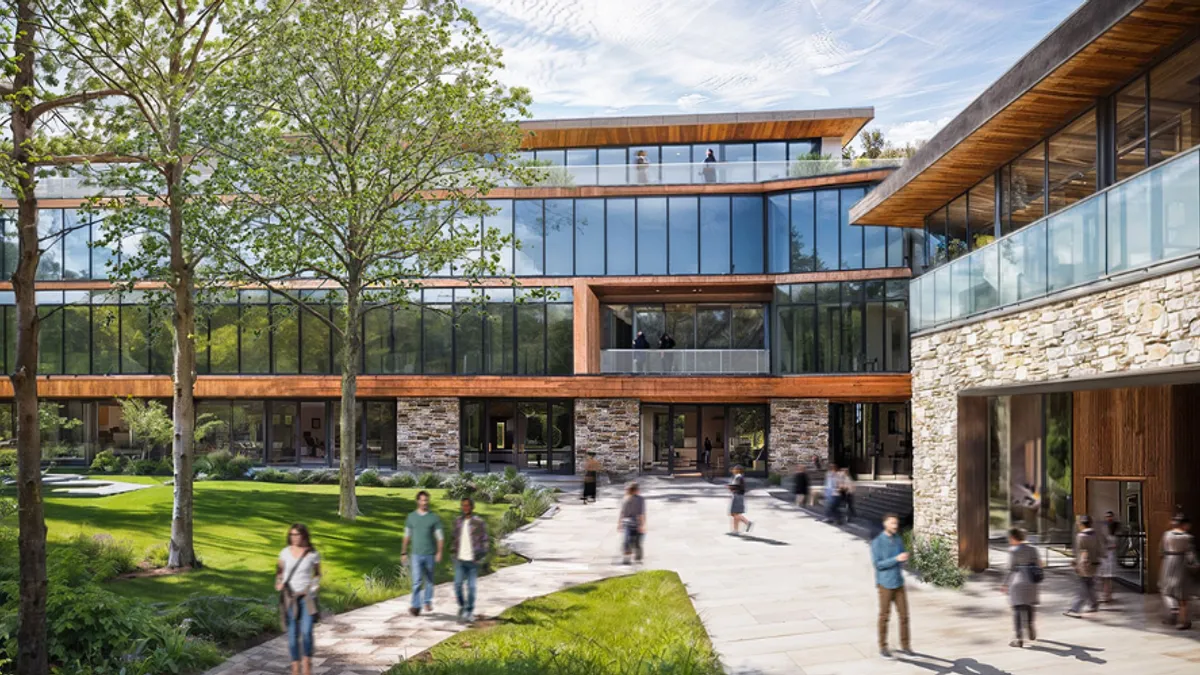This year was a big step for the construction industry, as it experienced strong growth in 2015 and is projected to see total activity growth of 13% in 2015 to $675 billion. We've covered all-things building this year, from the most outrageous niche stories to the major trends driving the industry.
Now, we're taking a look at our readers' perspective of the most compelling stories of the year, as we tracked the most-read feature articles published in 2015. And, unsurprisingly, our readers have hit the nail on the hard hat in flocking to the articles we consider the biggest trends and controversies in construction. Here are our most-read seven features of 2015, and why they matter to the industry:
1. 10 trends defining the construction industry
In August, we took a step back and outlined 10 of the biggest trends driving the construction industry. Dominated by labor shortages, BIM, apps and safety crackdowns, our list painted a broad picture of the major forces in the commercial and residential sectors. The strong technology presence on our list signaled the growing movement toward incorporating more tech innovations and apps into projects to streamline the construction process.
On the residential side, the housing market has continued to struggle with affordability concerns and the elusive millennial buyers, and that issue is expected to last well into 2016. And don't forget about tiny houses, the result of the small living movement that has many industry experts questioning its real effect on the residential industry.
Will these major trends continue into 2016? Or will new driving factors emerge in the industry?
2. A 'gotcha' move? Construction industry reacts to OSHA fine increase bombshell
The federal government slipped a major provision into the 2016 federal budget bill in November that could have a giant financial impact on the construction industry. The U.S. Department of Labor's Occupational Safety and Health Administration hasn't made an upward adjustment of fines since 1990, and the new budget directs the agency to raise them and, on a yearly basis, keep them in line with the Consumer Price Index.
The index has risen approximately 82% since 1990, so the initial change could see the dollar amount of OSHA fines skyrocket. For example, the current maximum penalty for a willful violation is $70,000, but, after adjustment for CPI, it would be $127,400. Even if the fact that OSHA often reduces fines by as much as 50%-60% is taken into consideration, employers could still be looking at major penalty amounts.
For many industry experts, the news of the provision's inclusion in the budget bill was unexpected. But some expressed the belief that OSHA's focus should be on education and outreach rather than on fines. "If they want to collect more in fines, that's their prerogative," said Brian Turmail, senior executive director of public affairs for the Associated General Contractors of America, "but let's not pat ourselves on the back. How much you collect in fines is a measure of how much you haven't educated the community you regulate."
The impending fine increase in 2016 will have a major impact on the industry, as construction fatalities accounted for 20.6% of all total private industry fatalities last year, according to the BLS.
3. Designing for the new buyer: 8 key home trends, and one industry 'game changer'
During the PCBC builders' show in June, we talked with residential experts about the biggest changes in constantly evolving homebuyer preferences. Architecture and planning group KTGY used research and feedback from builders and customers to determine several new home design trends driving today’s market. Nick Lehnert, executive director of KTGY, said builders should treat trends as somewhat of a checklist when designing a new home.
One of the biggest challenges for builders is determining how to take these items — which typically are applied in the luxury home market — and modify them to work for less-pricey residences. Affordability was a major topic of debate during the show, but experts agreed on one thing: Lower-earners are an untapped segment of the market, and builders should find ways to reach them. "That’s one of our biggest challenges, figuring out how these translate for more affordable homes," Lehnert said.
Those major home design trends include:
-
Personalization/"Idea spaces"
-
Super kitchens
-
Pet amenities
-
Spa-like master baths
-
Larger media areas
-
Smaller homes
-
Better indoor/outdoor connectivity
-
Larger garages
-
Tiny houses
4. Top 10 real estate trends for 2016
PricewaterhouseCoopers and the Urban Land Institute's annual "Emerging Trends in Real Estate" report for 2016, released in October, offered predictions of trends for the U.S. after expert interviews and surveys. The report highlighted that commercial real estate is becoming increasingly driven by smaller firms, as the growth of companies with fewer than 50 people is outpacing growth of larger ones.
"The real estate industry's traditional focus on big cities and large employers is shifting significantly as small businesses emerge as the growth engine for the U.S. economy," Mitch Roschelle, a partner at PwC, said in a release. "This is creating disruption in the office sector as it finds ways to create new space models to accommodate these employers."
Builders and developers should take note of these trends, as they can predict the best markets and sectors for growth next year. Some of the most notable predictions from the report include the rise of the 18-hour city, the continued popularity of the suburbs, evolving office spaces and alternative housing.
5. Tiny house trends: Timbercraft looks to capitalize on 'cute factor'
In the first installment of our "Tiny house trends" series in August, we talked with Doug Schroeder, a 20-year veteran of the homebuilding industry who founded Alabama-based Timbercraft Tiny Homes late last year as a side project to his main homebuilding business. But he quickly discovered the demand for tiny homes was stronger than he ever imagined. And now, he has tentative plans to shutter his traditional building business to focus exclusively on the tiny structures.
The tiny house movement has gained national attention, as shows like "Tiny House Nation" and "Tiny House Hunters" draw TV viewers, and demand from buyers for the small structures picks up. During the PCBC builders' show in June, building executives and industry insiders discussed tiny houses. Amy Albert, editor in chief of Professional Builder, said industry professionals should keep an eye on the growing trend, as it could have major implications for housing. But Nick Lehnert, executive director of KTGY, said he believes big building companies are hesitant to test the waters of the new market, despite growing demand, because "builders have a lemming mentality."
Since this first installment, we continued our "Tiny house trends" series, featuring companies finding untapped demand in the small home market, residents of the first public tiny house community in the country seeing the movement evolve, an architect who wants to adapt the trend to address problems of urban infill and a lack of affordability, and a new company with a focus on high-end, custom homes.
6. Tesla Powerwall buzz sparks booming demand for solar energy storage as new-home amenity
Quickly after Tesla's much-anticipated announcement of its new Powerwall product, which can store solar energy for the home to use after dark or on cloudy days, homebuilders and buyers were anxious to obtain the hyped technology.
In fact, Tesla received so many initial orders for its Powerwall after company President Elon Musk unveiled it in May that it will be filling them through 2016, Tesla has reported.
As buyers waited for the Powerwall to be ready to shipped, other homes with battery-power technology already in place were making headlines around the country. KB Home, for example, began experimenting with SunPower energy-storage systems in some solar-powered homes in California last year, with an eye toward rolling the technology out to a broader array of homeowners. The homes in the pilot program store solar power generated during the day for use during power outages.
Still, Tesla's Powerwall continues to dominate the energy storage narrative. Once the product is widely released — plans contingent upon Tesla's massive gigafactory construction — experts expect the Powerwall to have major implications for more widespread use of solar technology.
7. How BIM is revolutionizing the construction industry
Building Information Modeling, the broad term for the use of digital models in construction, is once again at the forefront of industry news as, next year, the United Kingdom — despite a few bumps — will begin requiring all public works contractors to be "BIM-ready." Affected U.K. contractors must comply with the technical requirements of Level 2 BIM — a basic, collaborative level that allows all parties on a project to exchange information via common file formats. U.K. government officials said they hope this move will allow them to see more efficiencies in all stages of a construction project.
BIM is also on the rise in the U.S. A new report from Transparency Market Research predicted the global BIM market, worth $2.6 billion in 2014, will grow to $11.54 billion by 2022.
Experts have said BIM provides tangible business benefits, no matter the level of implementation. Many have cited BIM's ability to provide more consistent, more accurate and less time-consuming project document generation. In addition, BIM users can expect better collaboration and coordination among the different parties involved in a project, according to industry users.
BIM has been a major part of large construction projects for years now, but the technology is seeping into more common projects and being used by smaller companies. The software is constantly evolving, and is now seeing a convergence with gaming tech. What innovations does BIM have in store during 2016?



















